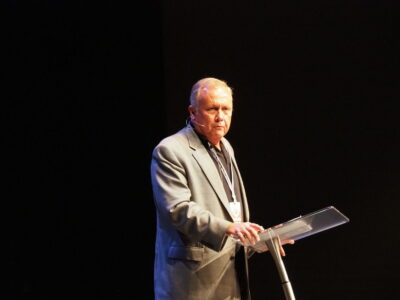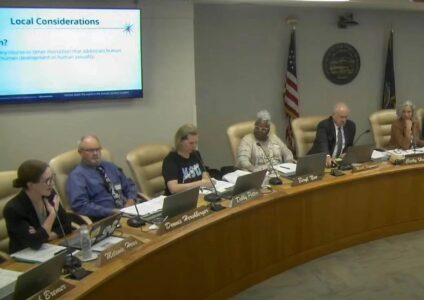Beyond the fame: Holcomb has changed much from the time Capote wrote his book
In the opening paragraphs of “In Cold Blood,” Truman Capote wrote: “Until one morning in mid-November of 1959, few Americans — in fact, few Kansans — had ever heard of Holcomb.”
Forty-five years later, Holcomb is widely known for the brutal killings of a local family only because of the book the crimes inspired Capote to write. In fact, some readers are more than familiar with the book — some seem almost obsessed.
A handful of people featured in the book still remain in the southwest Kansas community where Herbert Clutter, his wife, Bonnie, their daughter Nancy, and son, Kenyon, were murdered one night in November 1959. Overnight the crimes forever changed the lives of residents who had always lived with doors unlocked in a community where everyone knew everyone else and always felt secure.
Once the killers were brought to justice, people gradually resumed their routines. Today, if asked, many area residents say the murders, the book and two films based on it haven’t made a difference in their lives. Certainly the impact of those events and the publicity that visited the community are difficult to measure but unmistakable. Scholars and captivated readers of Capote’s book from as far as Europe and Japan have come to see for themselves what drew him to the case. With each new inquiry, residents seem compelled to recount their memories of that time, their feelings about the publicity and their opinions of Capote’s portrayals.
Mark Jarmer, a history, speech and philosophy professor at nearby Garden City Community College who has researched the Clutter murders on several occasions, said he knows many say their lives haven’t changed — but they’re wrong.
The violent nature of the crime and the fact that the killers were from outside the area contributed to an ongoing fear of newcomers, he said. That mistrust is evident today in matters small and large.
Signs of the crimes
Faithful readers of the book come to the community looking for signs of the murder and subsequent trial, and there are only a few — a photograph of Capote that hangs in the lobby of the Wheat Lands Motel where he stayed, the courthouse where Perry Smith and Richard Hickcock were prosecuted, the former Clutter house with its long lane lined with Chinese elms, the family’s graves.
What they find, too, in a place isolated by distance, is a community that is larger, more diverse and better educated than Capote described.

A lonely sign still marks Holcomb along the main railroad line that cuts between the town and the former River Valley farm. The town has grown tenfold in population, but its quiet lifestyle remains.
As an unofficial tour guide for the curious, Finney County Sheriff Kevin Bascue knows well the interest the book has sparked in the crime and his community.
Every year, Bascue says, law enforcement personnel drop in to see the books of police records about the Clutter case; high schools from the area and from out of state also ask to take Bascue’s tour of local points of interest in the case.
The book has given Holcomb an uncomfortable tourist attraction, but the crimes are not a distant enough memory for the community to capitalize on.
“Sixty miles from here, Dodge City used to be an outlaw town – a refuge for murderers in the Old Wild West. Now it draws huge tourism in for the city,” said Tim Hanigan, a dentist and president of the board of directors for the Garden City Chamber of Commerce. “But here, we are not far enough removed from the case for us to market it – maybe another 60 years before we market it.”
Any sort of marketing would further upset those who are exhausted by talking about that chapter of the past year after year, Jarmer said.
“They are opening wounds that are very real,” Jarmer said. “We still need to appreciate how deeply the wounds cut into these people.”
Holcomb then and now
Visitors use Capote’s book as a map to the past:
“The village of Holcomb stands on the high wheat plains of western Kansas, a lonesome area that other Kansans call ‘out there.’
“The land is flat, and the views awesomely extensive; horses, herds of cattle, a white cluster of grain elevators rising as gracefully as Greek temples are visible long before a traveler reaches them. Holcomb, too, can be seen from great distances. Not that there is much to see — simply an aimless congregation of buildings divided in the center by the main-line tracks of the Santa Fe Railroad, a haphazard hamlet bounded on the south by a brown stretch of the Arkansas River, on the north by highway, Route 50, and on the east and west by prairie lands and wheat fields.”
The seven-mile drive from Garden City to Holcomb is much as Capote described –horses, cattle and grain elevators. But farm buildings, houses, businesses and paved roads have filled the once-empty landscape. The “great American desert” now consists of crops and natural prairie among meatpacking plants and feedlots.
Holcomb, too, has changed since Capote wrote his book. Although there still are few businesses in town — only a couple of restaurants, Ron’s Market, a carwash, a bank branch, a laundry and the post office — far more homes have been built. Just 270 people lived there in 1960, but now the town boasts 2,026 residents, and Mayor Dennis Lauer said the population is increasing about 3 percent each year.
Population boomed in the 1980s with the arrival of big industry near Holcomb, and its presence is unmistakable. The Sunflower Electric Corp. plant is referred to as Holcomb Station. It opened south of town in 1983. To the west of Holcomb is the Tyson Foods Inc. plant — said to be the largest meatpacking plant in the world at a million square feet. Iowa Beef Processors Inc. opened the plant in 1980, and Tyson bought it in 2003. It provides about 3,000 jobs to the community and surrounding area.
One piece of Capote’s book still plays a central role in the community and remains where it was in 1959, right on Main Street.
Hartman’s Cafe was a meeting place for family and friends and a prime place for gossip about the crimes when Capote was making the rounds talking with the locals. It was operated by Bess Hartman and contained “four roughly made tables and a lunch counter,” that “could accommodate but a fraction of the frightened gossips, mostly male, who wished to gather there,” Capote wrote.
Now named El Rancho Cafe, it serves Mexican cuisine — frijoles (beans) with arroz (rice) served alongside enchiladas and burritos, far different from the “sandwiches, coffee, soft drinks and 3.2 beer” that Capote described on the menu in 1959. Today inside El Rancho, a picture of the old Hartman’s Cafe still hangs on the wall. It’s still a meeting place for family and friends, but the social and ethnic scene has changed.
An influx of migrant workers — mostly Latinos and Asians — arrived seeking jobs in the new industries.
Finney County is the second-largest county in Kansas in land mass and projected to grow in population almost 183 percent from 1990 to 2030. According to the 2000 Census, 50 percent of the population is white and 44 percent is Hispanic. In Holcomb, 80.8 percent of the population is white while 24.4 percent is Hispanic or Latino. And in Garden City the population is 68.8 percent white and 43.9 percent Latino or Hispanic. (Census figures do not always add up to 100 percent because respondents may describe themselves as being of more than one ethnicity.)
Southwest Kansas is considered one of the most ethnically diverse areas in the state, and Lauer said he doesn’t see a problem with integration of the two primary cultures, white and Latino, in the community.
Jarmer disagrees. He sees distinct lines among the cultures, which still don’t socialize. He said Garden City has Hispanic, Asian and white, middle-class neighborhoods, all clearly separated.
Jarmer traces the lack of integration to fear created by the Clutter murders.
“The lasting impact is a product of the community’s experiences,” he said. People locked their doors and remained strictly inside at night after the murders, but years later, fear and a cautious nature remain.
River Valley Farm today
From the cafe, it’s only about five blocks south on Main Street, past the railroad tracks, to Oak Avenue. To the west, Oak runs in to the lane to the old Clutter house and what they called River Valley Farm.
A few hundred yards south is a dry riverbed, what remains of the once-flowing Arkansas River, where Herb Clutter and his family played by the water’s edge, and where 16-year-old Nancy Clutter frequently rode her horse, Babe.
Capote captured these moments in his book: ” … the river, which was shallow here and strewn with islands — midstream beaches of soft sand, to which … picnic baskets had been carted, family afternoons whiled away waiting for a twitch at the end of a fishline.”
Such a lush place is no more.
The Arkansas River has been dry for the past seven years after alternating wet and dry periods. Because of the drought and growth in Holcomb, officials have made it a goal in recent years to continue to buy water rights from residents living at the edges of town, including Leonard and Donna Mader, current owners of the 480-acre Clutter farm, who were paid $750,000 in October 2004.
“Situated at the end of a long, lanelike driveway shaded by rows of Chinese elms, the handsome white house, standing on an ample lawn of groomed Bermuda grass, impressed Holcomb; it was a place people pointed out,” Capote said of the Clutter house.
The farm is still a handsome place, although its age shows. The once-full rows of Chinese elms hang ragged and sporadic along the dirt lane, and Herb’s beloved orchard along the banks of the river is now gone — both victims of scarce water.
The home has been tended with loving care since 1990 by the Maders, who moved into the house after raising their own children; they wanted more room for their children and visiting grandchildren. The Maders live with near-constant intrusion of fans of the book who want to see the scene of the crime. They have accepted the intrusions as a tradeoff for living in such a spacious place away from the center of town.
New schools attract notice
Although traffic is generally sparse in the center of Holcomb, it has one remarkably lively and crowded feature. The immense and modern Holcomb High School was built on the north side of town in 1982 with an addition in 2002. A new middle school stands nearby. One of the benefits of having huge industry in the community is a large tax base for education.
In 1959, Capote observed “… the Holcomb school, a good-looking establishment, which reveals a circumstance that the appearance of the community otherwise camouflages: that the parents who send their children to this modern and ably staffed ‘consolidated’ school … are, in general, a prosperous people.”
What was one school then is divided now into an elementary, middle and high school system that boasts four schools, with a total enrollment of 917. It’s the pride of Holcomb and the envy of the county, Lauer said.
“It’s what attracted my wife and I into the community,” he said. “We have an outstanding school system.”
Holcomb relies on Garden City for most other needs.
Garden City, with a population of 28,000, retains its historic downtown but has sprawled out into new residential, commercial and retail areas.
Just off Main Street, on which Capote described the “once-splendid Windsor Hotel,” which still stands, deserted, is the Finney County Courthouse, where Smith and Hickcock stood trial for the murders.
About a half-mile north on Main Street, where it intersects the old Highway 50, now East Kansas Avenue, stands the First United Methodist Church, where more than 1,000 people in a town of almost 12,000 attended the Clutters’ funeral in 1959.
A large, circular stained-glass window, known as the “Great Wheel Window,” faces south above the church’s main entrance. In December 1959, the window was dedicated to the Clutter family, who were members of the church. Herb Clutter served as chairman of the building committee for the church in 1952, was on its board and its pastoral relations committee and taught Hearthstone Sunday School for many years.
The church has not grown with the city, though, and has a congregation of 1,123 compared to 1,700 in 1959.
About a mile and a half north on Main Street is Valley View Cemetery. In the northwest corner — four rows from the north road and four rows from the west road — lie the Clutter graves.
It is a serene spot, as it was in 1959 when the graves were filled. The markers themselves are perhaps the only things that have not changed since then.
The nearby trees are larger and more mature, and the cemetery has grown around them. Nearby, other well-known names from the Clutter case can be seen among the gravestones: Alvin Dewey Jr., the KBI agent who led the investigation; Roland Tate, the judge; Arthur Fleming, the court-appointed attorney for Perry Smith; and Clarence Ewalt, who along with his daughter, Nancy, and a friend, Susan Kidwell, discovered the bodies of the Clutter family the morning after the murders.
What makes these gravesites different from those around them are the people who visit the graves — people from around the world who annually pay their respects to a family they learned about from a book.
James Hahn, the sexton at Valley View cemetery for 27 years, said in the course of a year, hundreds of people visit the graves. And they travel far. Hahn said several years ago some journalists came from Japan.
In an article for a special Garden City’s Telegram publication marking the 25th anniversary of the crimes, Dewey wrote that he wasn’t among the many people who still had bad feelings about Capote’s book.
“From hundreds of letters I received over the years from readers of a couple of generations, I think I have a pretty good idea of the way the Clutter family and the community are perceived by outsiders who read “In Cold Blood,” Dewey said. He said he believed people who read the book genuinely cared and were deeply affected by the crimes that befell the Clutter family. He also wrote that he didn’t think those who read the book perceived the area and its residents as Capote described them.
Even though the memory of the Clutters might fade with the generations, the book continues to live on in high school classrooms and on dusty bookshelves around the world. And as people continue to read Capote’s classic it is likely that visitors will continue to make pilgrimages to the tiny corner of southwest Kansas where it all happened.
“I think the Clutters will always be remembered, but the legacy will come from the book,” said Tony Jewell, a Garden City resident and former radio reporter who was the first journalist at the scene of the murders.
“It will always be there.”






